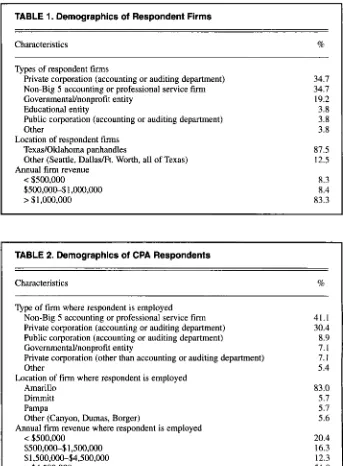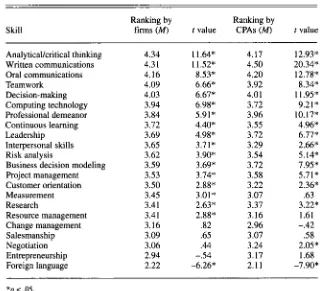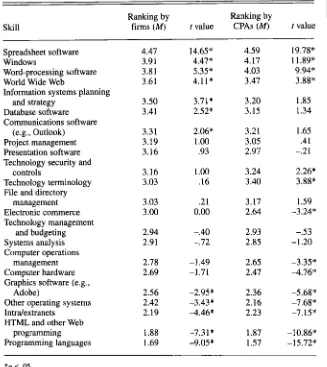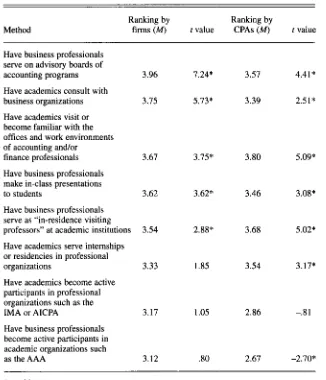Full Terms & Conditions of access and use can be found at
http://www.tandfonline.com/action/journalInformation?journalCode=vjeb20
Download by: [Universitas Maritim Raja Ali Haji] Date: 12 January 2016, At: 23:47
Journal of Education for Business
ISSN: 0883-2323 (Print) 1940-3356 (Online) Journal homepage: http://www.tandfonline.com/loi/vjeb20
The Future of Accounting Education: A Regional
Perspective
Sharon Burnett
To cite this article: Sharon Burnett (2003) The Future of Accounting Education: A Regional Perspective, Journal of Education for Business, 78:3, 129-134, DOI: 10.1080/08832320309599709
To link to this article: http://dx.doi.org/10.1080/08832320309599709
Published online: 31 Mar 2010.
Submit your article to this journal
Article views: 292
View related articles
Education:
The
Future
of
Accounting
A
Regional Perspective
SHARON BURNETT
zyxwvutsrqponmlkjihgfedcbaZYXWVUTSRQPONMLKJIHGFEDCBA
West
Texas
A&M
zyxwvutsrqponmlkjihgfedcbaZYXWVUTSRQPONMLKJIHGFEDCBA
UniversityCanyon, Texas
ill the accounting profession sur-
W
vive? If so, how must accounting education change to cope with the chang- ing landscape of the financial world? In this time of financial and economic strife, these questions are on in the minds of accountants and educators.For over a decade, some accounting professionals and researchers have advocated change in the accounting education system. In 1989, the “Big 8”
CPA firms issued
zyxwvutsrqponmlkjihgfedcbaZYXWVUTSRQPONMLKJIHGFEDCBA
Perspectives on Edu- cation: Capabilities for Success in theAccounting Profession (Arthur Ander-
sen
zyxwvutsrqponmlkjihgfedcbaZYXWVUTSRQPONMLKJIHGFEDCBA
& Co. et al., 1989), which called for changes in accounting education. In1990, the Accounting Education Change Commission (AECC) selected 13 schools for modification of their approach to accounting education. Since that time, some schools have made changes; most states instituted the 150-hour rule that resulted in changes in curriculum; and the number and quality of accounting majors have declined (Albrecht & Sack, 2000; Chabrow &
Hayes, 2001). Now, more than ever, it is imperative that changes be made for accounting education to survive.
In late 1999, four organizations came together to sponsor a study of the future of accounting education: the American Accounting Association (AAA), the American Institute of Certified Public Accountants (AICPA), the Institute of
ABSTRACT. Accounting education
is under pressure to change its current teaching methods. In this study, the
authors surveyed employers of their university’s accounting graduates and
members of a local CPA chapter to ascertain which skills are important
for new graduates and which educa- tional innovations are effective. The top-rated four professional skills were
analytical/critical thinking, written communication, oral communication,
and decision-making. The top three technology skills included spreadsheet software, Windows, and word-pro- cessing software. The top education innovation was internships. These
results agree with a national survey completed in 1999.
Management Accountants (IMA), and the “Big 5” professional service firms (Arthur Andersen, KPMG, Pricewater- housecoopers, Ernst & Young, and Deloitte & Touche). W. Steve Albrecht and Robert J. Sack were asked to “write a high-level thought piece, backed by empirical evidence where possible, that would motivate serious change in accounting education” (Albrecht &
Sack, 2000, p. vii). The final product, published in 2000, was a monograph,
Accounting Education: Charting the Course Through a Perilous Future (“the
monograph”), based on interviews with key business, accounting, and education leaders; focus-group sessions with indi- viduals nominated by the four sponsor- ing organizations; the Ross Institute
Roundtable at New York University; 783 questionnaire replies from account- ing practitioners and accounting educa- tors; and 134 questionnaire replies from active accounting department chairs. The report concluded that accounting education is indeed in serious trouble and must change quickly and signifi- cantly to survive.
Purpose of Study
Since the issuance of the monograph, there has been some criticism of that
study as having a “national school, Big
zyxwvutsrqponmlkjihgfedcbaZYXWVUTSRQPONMLKJIHGFEDCBA
5” bias (Hoppe, 2000). The nationalschools are the major suppliers of grad-
uates to the Big
zyxwvutsrqponmlkjihgfedcbaZYXWVUTSRQPONMLKJIHGFEDCBA
5 professional service firms. Although this might seem tocover a large number of the accounting population, there are a multitude of smaller, regional schools in the United States, non-Big 5 firms, and other non- public accounting entities that hire accountants. In addition, the monograph urged each higher learning institution to decide for itself how to respond to the current call for change in accounting education (Albrecht & Sack, 2000).
West Texas A&M University (WTAMU) is a regionally accredited university in the Panhandle of Texas. The university offers both undergradu- ate and master’s degrees in accounting along with a combined bachelor’s/mas-
January/February 2003 129
ter’s 5-year accounting degree. It is a regional university that supplies stu-
dents mostly to non-Big
zyxwvutsrqponmlkjihgfedcbaZYXWVUTSRQPONMLKJIHGFEDCBA
5 employers. Itis important that our accounting pro- gram assessment determine whether the results reported in the monograph are representative of our constituents, both employers of our accounting graduates and individual CPAs. The use of employers for program assessment feedback was validated in a 1999 com- mittee report from the AAA assessment
task force (as cited in Gabbin, 2002).
zyxwvutsrqponmlkjihgfedcbaZYXWVUTSRQPONMLKJIHGFEDCBA
Method
To obtain perceptions from the employers of our accounting graduates, we obtained a list of the most recent firms interviewing on campus from the Career Services Office. To that list we added other firms known to have hired accounting graduates in the past (based upon discussions with other accounting professors). In fall 2001, we sent a let- ter to 116 employer firms with a request for their responses to an anonymous online survey regarding accounting education.
To obtain perceptions from accoun- tants, we then administered the survey to a local group of CPAs. In February 2002, we e-mailed 357 members of the Panhandle Chapter of the Texas Society of Certified Public Accountants with a request for their completion of the anonymous online survey. (Because the survey was anonymous, some duplica- tion of responses between the two groups may have occurred. Therefore, we analyzed the groups separately.)
The survey was a streamlined version of the “Survey of Accounting Practi- tioners” as explained in the monograph. To reduce the time necessary to com- plete the survey, we included only the most pertinent questions regarding accounting education. In several instances, we expanded the scale to pro- vide better measurement of responses.
Results
For the first survey, we received 32 employer responses, representing a response rate of 27.6%. The respondent firms were primarily private corpora- tions and non-Big 5 accounting or pro-
130
zyxwvutsrqponmlkjihgfedcbaZYXWVUTSRQPONMLKJIHGFEDCBA
JournalzyxwvutsrqponmlkjihgfedcbaZYXWVUTSRQPONMLKJIHGFEDCBA
of Education for Businessfessional service firms (see Table 1). We refer to the respondents from this group as “respondent firms.”
We received 76 responses to the sec- ond survey, for a response rate of 2 1.7%. The CPAs were primarily from private corporations and non-Big 5 accounting or professional service firms (see Table 2). We refer to the respondents from this group as “CPA respondents.”
Most of the respondent firms (91%) indicated that accounting education was meeting the needs and expectations of accounting professionals by answering
okay or well. On a scale ranging from 1
zyxwvutsrqponmlkjihgfedcbaZYXWVUTSRQPONMLKJIHGFEDCBA
(very poorly) to 5 (very well), the mean
response was 3.34. Of the CPA respon- dents, 85.5% felt that accounting educa- tion was performing okay or well. The mean response was 3.23. These results indicate that the firms and CPAs were not especially dissatisfied with account- ing education today. However, we con- cluded that room for improvement exists because only one respondent answered very well, and over half of the
respondents answered okay.
To give a robust description of the sur- vey respondents’ curriculum priorities, we asked them which topics should receive the most coverage in college courses. The respondent firms said that
TABLE 1. Demographics of
zyxwvutsrqponmlkjihgfedcbaZYXWVUTSRQPONMLKJIHGFEDCBA
Respondent FirmsCharacteristics
zyxwvutsrqponmlkjihgfedcbaZYXWVUTSRQPONMLKJIHGFEDCBA
%Types of respondent firms
Private corporation (accounting or auditing department) Non-Big 5 accounting or professional service firm Governmentalhonprofit entity
Educational entity
Public corporation (accounting or auditing department) Other
Texas/Oklahoma panhandles
Other (Seattle, Dallasmt. Worth, all of Texas)
< $500,000
$500,000-$1,000,000
> $1,000,000
Location of respondent firms
Annual firm revenue
34.7
34.7
19.2
3.8
3.8 3.8 87.5 12.5 8.3
[image:3.612.223.566.257.723.2]8.4 83.3
TABLE 2. Demographics of CPA Respondents
Characteristics %
Type of firm where respondent is employed
Non-Big 5 accounting or professional service firm
Private corporation (accounting or auditing department)
Public corporation (accounting or auditing department) Governmentalhonprofit entity
Private corporation (other than accounting or auditing department) Other
Amarillo
Dimmitt Pampa
Other (Canyon, Dumas, Borger)
< $500,000
$500,000-$1,500,000 $1,500,000-$4,500,000
> $4,500,000
Location of firm where respondent is employed
Annual firm revenue where respondent is employed
41.1 30.4 8.9
7.1
7.1 5.4
83.0
5.7
5.7 5.6 20.4 16.3 12.3 51.0
the five most important courses were, in order of importance, financial account- ing, information systems, auditing/assur- ance services, business strategy, and managerial accounting. The CPA respon- dents felt that the five most important courses were financial accounting, taxes, finance, auditing/assurance services, and information systems. These results indi- cate agreement between the groups on the need for course coverage in financial accounting, auditing/assurance services, and information systems.
As part of the survey, respondents answered questions pertaining to the following areas: professional skills, technology skills, academic-profession- a1 interaction methods, and outside-the- classroom learning activities. Using the following equation as explained in Iman and Conover (1989, p. 305), we calcu-
lated a t
zyxwvutsrqponmlkjihgfedcbaZYXWVUTSRQPONMLKJIHGFEDCBA
value to test for significance: T,zyxwvutsrqponmlkjihgfedcbaZYXWVUTSRQPONMLKJIHGFEDCBA
= [dn
zyxwvutsrqponmlkjihgfedcbaZYXWVUTSRQPONMLKJIHGFEDCBA
(X - p,)]zyxwvutsrqponmlkjihgfedcbaZYXWVUTSRQPONMLKJIHGFEDCBA
/ s.Professional Skills
Using a 5-point Likert scale, the respondents prioritized a list of profes- sional skills. As we show in Table 3,
both respondent groups strongly agreed that 15 skills out of the 22 listed were
important enough for both in-class and out-of-class activities, even if the activ- ities would require sacrificing some content learning. Both groups ranked analyticaUcritica1 thinking, written communication, oral communication, and decision-making among their top five choices. Both groups felt that development of a foreign language did not warrant both in-class and out-of- class activities.
Technology Skills
Once again using a 5-point Likert scale, the respondents indicated whether it was important for new accounting hires to possess different technology skills. Both groups strongly agreed that the top four technology skills, in order of importance, were spreadsheet software (e.g., Excel), Windows, word-processing software (e.g., Word), and the World Wide Web (see Table 4). Clearly the respondents viewed spreadsheets as the most impor-
tant technology skill. Neither group
zyxwvutsrqponmlkjihgfedcbaZYXWVUTSRQPONMLKJIHGFEDCBA
TABLE 3. Professional Skills That Respondents Considered Important to
Develop During Education
Ranking by Ranking by
Skill firms
zyxwvutsrqponmlkjihgfedcbaZYXWVUTSRQPONMLKJIHGFEDCBA
(M) tvalue CPAs (M) tvalueAnalyticalhitical thinking Written communications Oral communications Teamwork Decision-making Computing technology Professional demeanor Continuous learning Leadership Interpersonal skills Risk analysis
Business decision modeling Project management Customer orientation Measurement Research Resource management Change management Salesmanship Negotiation Entrepreneurship Foreign language 4.34 4.3 1
4.16 4.09 4.03 3.94 3.84 3.72 3.69 3.65 3.62 3.59 3.53 3.50 3.45 3.41 3.41 3.16 3.09 3.06 2.94 2.22
1 1.64* I 1.52" 8.53* 6.66* 6.67* 6.98* 5.91* 4.40* 4.98" 3.71* 3.90* 3.69* 3.74* 2.88" 3.01* 2.63* 2.88* .82 .65 .44 -.54 -6.26* 4.11 4.50 4.20 3.92 4.01 3.72 3.96 3.55 3.72 3.29 3.54 3.72 3.58 3.22 3.07 3.37 3.16 2.96 3.07 3.24 3.17 2.11 12.93* 20.34* 12.78* 8.34" 11.95* 9.21* 10.17" 4.96* 6.77" 2.66* 5.14" 7.95" 5.71" 2.36" .63 3.22"
1.61
zyxwvutsrqponmlkjihgfedcbaZYXWVUTSRQPONMLKJIHGFEDCBA
.58
2.05* I .68 -.42
-7.90*
* p < .05.
thought that it was important for new hires to have developed skills in graph- ics software, other operating systems, intra/extranets, html/Web program- ming, and programming languages.
Academic-Professional Interaction Methods
Next, the respondents were asked to indicate the effectiveness of several col- laborative methods that academics and professionals could use to improve accounting education. On a 5-point Lik- ert scale, both groups strongly agreed that six of the eight methods listed were effective for bringing academia and practitioners together (see Table 5 ) . The respondent firms preferred advisory boards, whereas the CPA respondents favored having academicians visit or become familiar with the actual offices and work environments.
Outside-the-Classroom Learning Activities
Finally, the respondents allocated 20 points among six learning activities, ranging from accounting internships to foreign business trips. The activity that received by far the most points was "3-4-month internships with compa- nies" (see Table 6). Both groups of respondents saw internships as prefer- able to field projects, service learning assignments, and shadowing profes- sionals. The respondents apparently preferred longer activities in which par- ticipants could become familiar with the accounting environment.
Comparison With the Monograph
Overall, the results of our survey of firms and CPAs were similar to the results reported in the monograph. Although in some instances the scales varied between our survey and the monograph, many of the outcomes can be compared. Generally, all data seem to indicate that the respondents were not greatly dissatisfied with accounting education today. The monograph respondents rated accounting education as a 2.69 on a 4-point scale with 4 rep- resenting very well. As discussed, both the respondent firms and the CPAs rated
January/February 2003 131
[image:4.612.55.380.437.728.2]TABLE 4. Technology Skills That Respondents Considered Important for
New Hires to Possess
zyxwvutsrqponmlkjihgfedcbaZYXWVUTSRQPONMLKJIHGFEDCBA
Ranking by Ranking by
Skill firms
zyxwvutsrqponmlkjihgfedcbaZYXWVUTSRQPONMLKJIHGFEDCBA
(M)zyxwvutsrqponmlkjihgfedcbaZYXWVUTSRQPONMLKJIHGFEDCBA
t value CPAs (M) tvalue Spreadsheet softwareWindows
Word-processing software World Wide Web
Information systems planning
and strategy
Database software Communications software
(e.g., Outlook) Project management
Presentation software Technology security and Technology terminology File and directory
management Electronic commerce Technology management
and budgeting Systems analysis Computer operations
management Computer hardware
Graphics software (e.g.,
Other operating systems Intrdextranets HTML and other Web
Programming languages
controls Adobe) programming 4.47 3.91 3.81 3.61 3.50 3.41 3.31 3.19 3.16 3.16 3.03 3.03 3.00 2.94 2.91 2.78 2.69 2.56 2.42 2.19 1.88 1.69 14.65* 4.47” 5.35*
4.1 I* 3.7 1
*
2.52* 2.06* 1 .00
.93
1
.oo
.16 .21 0.00 -.40 -.72 -1.49 -1.71 -2.95* -3.43” -4.46* -7.31* -9.05* 4.59 4.17 4.03 3.47 3.20 3.15 3.21 3.05 2.97 3.24 3.40 3.17 2.64 2.93 2.85 2.65 2.47 2.36 2.16 2.23 1.87 1.57 19.78*
1 1.89* 9.94* 3.88* 1.85 1.34 1.65 .4 1
-.21 2.26* 3-88” 1.59 -3.24* -.53 -1.20 -3.35* 4 7 6 * -5.68* -7.68* -7.15* -10.86* -15.72*
* p < .05.
zyxwvutsrqponmlkjihgfedcbaZYXWVUTSRQPONMLKJIHGFEDCBA
accounting education as well above 3 on a 5-point scale.
More specifically, the monograph pro- vided data that are used for comparison purposes in three areas: professional skills, technology skills, and outside-the- classroom learning activities. With regard to professional skills, the mono- graph respondents agreed with our respondents that the top three profession- al skills were analytical/critical thinking, written communication, and oral com- munication. The monograph respondents also ranked the importance of technology skills. As in our study, the top three tech- nology skills were spreadsheet software, word-processing software, and Win- dows. The final comparison related to the value of outside activities. Again, consis- tent with the current study, the mono- graph respondents ranked 34-month internships the highest.
132
zyxwvutsrqponmlkjihgfedcbaZYXWVUTSRQPONMLKJIHGFEDCBA
Journal of Education for BusinessDiscussion and Conclusion
The results of our study seem to val- idate the monograph results, suggest- ing a general consensus among accountants and employers of accoun- tants. Despite the presumably different respondent samples (big school, Big 5
versus regional school, non-Big 5 ) , we found no glaring contradictions between the monograph and the cur- rent study.
Based upon the above results, several important points should be considered in the assessment and improvement process for any accounting program. The top four professional skills-writ- ten communication, analyticalkritical thinking, oral communication, and deci- sion-making-correspond directly to the AECC’s Position Statement Number One (1990):
To become successful professionals, accounting graduates must possess com- munication skills, intellectual skills, and interpersonal skills. Communication skills include both receiving and transmit-
ting information and concepts, including effective reading, listening, writing and
speaking. Intellectual skills include abili-
ty to locate, obtain, and organize informa-
tion and the ability to identify and solve unstructured problems in unfamiliar set- tings and to exercise judgment based on
comprehension of
zyxwvutsrqponmlkjihgfedcbaZYXWVUTSRQPONMLKJIHGFEDCBA
an unfocused set offacts. Interpersonal skills include the abil- ity to work effectively in groups and to
provide leadership when appropriate. (pp.
In addition, the more recent CPA Vision Project, with input from CPAS across the country, reflects similar find- ings. The first two of the “Top Five Core Competencies” determined by the Vision Project are “communication and leadership skills” and “strategic and critical thinking slulls” (AICPA, 1998). The four professional skills should be developed throughout the curriculum rather than in just one or two courses. Some classes are more suitable for the cultivation of certain skills than others. For instance, the accounting theory class is particularly appropriate for fos- tering analyticalkritical thinking and decision-making skills. Almost any class can incorporate decision-making, although the auditing class seems espe- cially well suited for this. Oral and writ- ten communication skill development should be an integral part of all upper level classes. The top four professional skills are important enough to warrant consideration of reducing of some con- tent areas to ensure thorough develop- ment of these skills. Accounting rules will change, but the need for these skills will not.
With respect to technology skills, a single accounting systems class along with one or two generic computer courses may not be adequate. A better approach might be to require more tech- nology applications, particularly spreadsheets, in all other accounting classes, in addition to the accounting systems class. Students also should be trained in the use of Windows and word- processing applications.
Northern Illinois University (NIU) determined that certain skills, including problem solving, using spreadsheets,
307-308)
[image:5.612.57.384.79.446.2]and decision-making, were important enough to ensure their coverage in their core accounting courses. Cummings,
Bennett, and Normand (2001) provided a table indicating where these skills are
included in the core courses at NIU.
zyxwvutsrqponmlkjihgfedcbaZYXWVUTSRQPONMLKJIHGFEDCBA
TABLE 5. Respondents’ Perceptions of importance of Ways That Academics and Professionals Can Work Together
Ranking by Ranking by
Method firms
zyxwvutsrqponmlkjihgfedcbaZYXWVUTSRQPONMLKJIHGFEDCBA
(M) tvalue CPAs (M) tvalueHave business professionals serve on advisory boards of accounting programs
Have academics consult with business organizations
Have academics visit or become familiar with the offices and work environments of accounting andor
finance professionals
Have business professionals make in-class presentations to students
Have business professionals serve as “in-residence visiting professors” at academic institutions
Have academics serve internships or residencies in professional organizations
Have academics become active participants in professional organizations such as the IMA or AICPA
Have business professionals become active participants in academic organizations such as the AAA
3.96
3.75
3.67
3.62
3.54
3.33
3.17
3.12
7.24*
5.73*
3.751;
3.62*
2.88*
1.85
1.05
.80
3.57
3.39
3.80
3.46
3.68
3.54
2.86
2.67
4.41*
2.5 1
*
zyxwvutsrqponmlkjihgfedcbaZYXWVUTSRQPONMLKJIHGFEDCBA
5.09*
3.08”
5.02*
3.17*
-.81
-2.70*
zyxwvutsrqponmlkjihgfedcbaZYXWVUTSRQPONMLKJIHGFEDCBA
* p < .05.
zyxwvutsrqponmlkjihgfedcbaZYXWVUTSRQPONMLKJIHGFEDCBA
TABLE 6.Out-of-Classroom Learning Activities That Respondents Considered important
Respondent firms Respondent CPAs Total points Total points
Activity allocated Points (M) allocated Points (M)
34-month internships
Service leaming
Field study projects with
Shadowing professionals 67 2.09 143 2.86 On-line (Internet) classes 55 1.72 88 2.05 Foreign business trips 14 .44 24 .62
with companies 254 7.93 645 9.08
assignments 106 3.3 1 256 4.49
real companies 107 3.34 171 3.49
Each accounting program should adopt some type of methodology to show how these important skills are covered.
All respondent groups agreed that the best outside-the-classroom learning activity is an internship. Most universi- ties have recognized the benefits of internships and actively promote them to students and the business community. In addition, many respondents believed that the establishment of accounting program advisory boards would provide a forum for effective collaboration between business professionals and aca- demics. Once again, many accounting programs have already implemented this concept (AAA, 1999). The advan- tages include not only advice, but also stronger university-community relation- ships and broader employment opportu- nities for graduates (“Framework high- lights need.. .,” 2001).
Accounting education must make changes to survive in the current eco- nomic and business environment. How- ever, change without proper direction and focus could prove worse than no change at all. The findings in this study provide further evidence on how changes might proceed at different tiers of colleges and universities. Accounting education must continue to explore and implement alternatives into accounting programs.
ACKNOWLEDGMENT
We gratefully acknowledge the financial sup- port of the Accounting, Economics, & Finance Department at West Texas A&M University and the cooperation of the Panhandle Chapter of the Texas Society of Certified Public Accountants.
REFERENCES
Accounting Education Change Commission
(AECC). (1990, Fall). Objectives of education
zyxwvutsrqponmlkjihgfedcbaZYXWVUTSRQPONMLKJIHGFEDCBA
for accountants: Position Statement Number One. Issues in Accounting Education, 5(2),
307-3 12.
Albrecht, W., & Sack
zyxwvutsrqponmlkjihgfedcbaZYXWVUTSRQPONMLKJIHGFEDCBA
R. (2000). Accounting edu-cation series, accounting education: Charting the course through a perilous future (Vol. 16). Sarasota, FL: American Accounting Associa- tion.
American Accounting Association (AAA). (1999, Fall). Fall 1999 benchmark study ques- tion 12 accounting advisory boards cohort comparison. Retrieved from http://account-
ing.rutgers.edu/raw/aaa/partners/APLG-Lim b erg.pdf
American Institute of Certified Public Accoun- tants (AICPA).(1998, April). CPA Vision Pro- ject identifies top five issues for profession. The CPA Letter I , 12.
Chabrow E., & Hayes, M. (2001, June 18).
January/February 2003 133
[image:6.612.57.383.125.505.2]Changes in accounting education.
zyxwvutsrqponmlkjihgfedcbaZYXWVUTSRQPONMLKJIHGFEDCBA
Informa-tionweek. Retrieved April 3, 2002 from
zyxwvutsrqponmlkjihgfedcbaZYXWVUTSRQPONMLKJIHGFEDCBA
http://www.informationweek.comlstory/IWK2
0010614S0024
Cummings, B., Bennett R. E.,
zyxwvutsrqponmlkjihgfedcbaZYXWVUTSRQPONMLKJIHGFEDCBA
& Normand C. J.(2001, Winter). Meeting the challenge: The university accounting program corporate America needs. Management Accounting
Quarterly. Retrieved June 25, 2002 from
zyxwvutsrqponmlkjihgfedcbaZYXWVUTSRQPONMLKJIHGFEDCBA
http://www.mamag.com/winterO l/wOlcummi
ngs.htm
Framework highlights need to close communica- tion between practice and academe. (2001, April-June). Ohio CPA Journal [Online] 60(2), 52-53. Available: EBSCOhost. File: Business Source Premier retrieved January 2 1, 2002.
Gabbin A. L. (2002, April). The crisis in account- ing education. Journal of Accountancy, 193(4),
Hoppe, P. (2000, November 25). Welcome to rhe “Perilous” Discussion Forum. Message post- 81-86.
ed to http://aaahq.org:8888/webx?50@4. EvZWabeGaHi”O@ .eec29a4
[man, R. I. & Conover, W. J. (1989). Modern busi- ness stutistics (2nd ed.). New York: Wiley. Arthur Andersen & Co., Arthur Young, Coopers &
Lybrand, Deloitte Haskins & Sells, Ernst & Whinney, Peat Manvick Main & Co., Price Waterhouse, and Touche Ross (The Big 8).
( I 989). Perspectives on education: Capabilities
f o r success in the accounting profession. New York: Author.
JOURNAL OF
EDUCATION
FOR
BUSINESS
zyxwvutsrqponmlkjihgfedcbaZYXWVUTSRQPONMLKJIHGFEDCBA
m m m m m m m m m m m m m m m m m m m m m D ~ B
w
ORDER FORM
0
YES!
I would like to order a one-year subscription to the Journal of Education for Business published bimonthly. I understand payment can be made to HeldrefPublications or charged to my VISAlMasterCard (circle one).
$47.00 Individuals $80.00 Institutions
ACCOUNT # EXPIRATION DATE SIGNATURE
NAME/INSTITUTION ADDRESS ClTYlSTATEEl P COUNTRY
ADD $16.00 FOR POSTAGE OUTSIDE THE US. ALLOW 6 WEEKS FOR DELIVERY OF FIRST ISSUE.
SEND ORDER FORM AND PAYMENT TO:
HELDREF PUBLICATIONS, Journal of Education for Business
1319 EIGHTEENTH ST., NW, WASHINGTON, DC 20036-1802 PHONE (202) 296-6267 FAX (202) 296-5149
SUBSCRIPTION ORDERS 1(800)365-9753, www.heldref.org
The Journal of Education for Business readership
includes instructors, supervi- sors, and administrators at the secondary, post- secondary, and collegiate levels. The Journal features basic and applied research- based articles in accounting, communications, economics, finance, information sys- tems, management, market- ing, and other business dis- ciplines. Articles report or share successful innovations, propose theoretical formula- tions, or advocate positions on important controversial issues and are selected on a blind, peer-reviewed basis.
134 Journal of Education for Business



